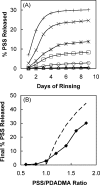Saloplastic Macroporous Polyelectrolyte Complexes: Cartilage Mimics
- PMID: 21132107
- PMCID: PMC2994323
- DOI: 10.1021/ma1012978
Saloplastic Macroporous Polyelectrolyte Complexes: Cartilage Mimics
Abstract
Complexes of sodium poly(4-styrenesulfonate) (NaPSS) and poly(diallyldimethylammonium chloride) (PDADMAC) were formed on mixing equimolar solutions in high salt concentration. Under ultracentrifugal fields, the complex precipitates were transformed into compact polyelectrolyte complexes (CoPECs), which showed extensive porosity. The mechanical properties of CoPECS make them attractive for bioimplants and tissue engineering applications. Free NaPSS chains in the closed pores of CoPECs create excess osmotic pressure, which controls the pore size and contributes to the mechanical resistance of the material. The mechanical properties of CoPECs, modulated by the ionic strength of the doping medium, were studied by uniaxial tensile testing and the stress-strain data were fit to a three-element Maxwell model which revealed at least two regimes of stress relaxation.
Figures










Similar articles
-
Compact polyelectrolyte complexes: "saloplastic" candidates for biomaterials.Biomacromolecules. 2009 Nov 9;10(11):2968-75. doi: 10.1021/bm900373c. Biomacromolecules. 2009. PMID: 19835412 Free PMC article.
-
On the benefits of rubbing salt in the cut: self-healing of saloplastic PAA/PAH compact polyelectrolyte complexes.Adv Mater. 2014 Apr 23;26(16):2547-51. doi: 10.1002/adma.201304991. Epub 2014 Jan 29. Adv Mater. 2014. PMID: 24478263
-
Saloplastics: processing compact polyelectrolyte complexes.Adv Mater. 2015 Apr 17;27(15):2420-32. doi: 10.1002/adma.201500176. Epub 2015 Mar 13. Adv Mater. 2015. PMID: 25771881 Review.
-
Antiviral and antibacterial activity of sodium alginate/poly(diallyldimethylammonium chloride) polyelectrolyte film for packaging applications.Int J Biol Macromol. 2023 Jul 31;244:125388. doi: 10.1016/j.ijbiomac.2023.125388. Epub 2023 Jun 15. Int J Biol Macromol. 2023. PMID: 37330082
-
A Perspective on the Glass Transition and the Dynamics of Polyelectrolyte Multilayers and Complexes.Langmuir. 2023 Oct 24;39(42):14823-14839. doi: 10.1021/acs.langmuir.3c00974. Epub 2023 Oct 11. Langmuir. 2023. PMID: 37819874 Free PMC article. Review.
Cited by
-
Explicit Ion Effects on the Charge and Conformation of Weak Polyelectrolytes.Polymers (Basel). 2019 Jan 21;11(1):183. doi: 10.3390/polym11010183. Polymers (Basel). 2019. PMID: 30960167 Free PMC article.
-
Challenges in creating dissectible anatomical 3D prints for surgical teaching.J Anat. 2019 Apr;234(4):419-437. doi: 10.1111/joa.12934. Epub 2019 Feb 1. J Anat. 2019. PMID: 30710355 Free PMC article. Review.
-
Plant cell-inspired colon-targeted cargo delivery systems with dual-triggered release mechanisms.Sci Adv. 2025 May 16;11(20):eadt2653. doi: 10.1126/sciadv.adt2653. Epub 2025 May 14. Sci Adv. 2025. PMID: 40367175 Free PMC article.
-
Improving the fixed charge density of sustainably produced saloplastic anion exchange membranes.RSC Sustain. 2025 Jun 17;3(8):3473-3482. doi: 10.1039/d5su00221d. eCollection 2025 Jul 30. RSC Sustain. 2025. PMID: 40568526 Free PMC article.
-
Achieving lysozyme functionalization in PDADMAC-NaPSS saloplastics through salt annealing.RSC Adv. 2024 Oct 18;14(45):32863-32875. doi: 10.1039/d4ra04986a. eCollection 2024 Oct 17. RSC Adv. 2024. PMID: 39429930 Free PMC article.
References
-
- Peng H. T.; Martineau L.; Shek P. N. J. Mater. Sci. Mater. Med. 2007, 18, 975–986. - PubMed
-
- Tanaka Y.; Gong J. P.; Osada Y. Prog. Polym. Sci. 2005, 30, 1–9.
-
- Biot M. A. J. Appl. Phys. 1955, 26, 182–185.
-
- Mak A. F. J. Biomech. Eng. 1986, 108, 123–130. - PubMed
-
- Mow V. C.; Kuei S. C.; Lai W. M.; Armstrong C. G. J. Biomech. Eng. 1980, 102, 73–84. - PubMed
Grants and funding
LinkOut - more resources
Full Text Sources
